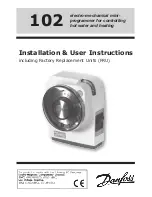
A . 4
■
A p p e n d i x
Wa t l o w S e r i e s 9 7
Modbus Remote Terminal Unit (RTU)
Modbus RTU enables a computer or PLC to read and write directly to registers
containing the controller’s parameters. With it you could read all 141 of the
controller’s parameters with five read commands.
Because of the wide array of choices available for setting up a Series 97
controller, only a subset of the prompts contain parameters in a given situation.
This manual explains the interrelations between prompts. A Modbus read
command response of -32000 indicates that a register is not implemented;
-32001, register not active; or -32002, not read accessible. A write command will
return an exception response of 01 to indicate an illegal function, 02, illegal
register; or 03, illegal data. If you try to write to an inactive prompt the
controller will return an illegal data address message (02).
If you already have a software application that uses Modbus, you can simply
skip to the Temperature/process Controller Prompt Table or the Modbus RTU
Address Table in this chapter for the address information your program will
need. The rest of this section on the Modbus provides information for writing a
software application that uses Modbus.
Writing a Modbus Application
You need to code messages in eight-bit bytes, with no parity bit, one stop bit (8,
n, 1). Negative parameter values must be written in twos complement format.
Parameters are stored in two-byte registers accessed with read and write
commands to a relative address.
Messages are sent in packets that are delimited by a pause at least as long as
the time it takes to send 30 bits. To determine this time in seconds, divide 30 by
your baud rate.
Because changing some parameters automatically changes or defaults other
parameters, use the Complete Parameter Download Sequence table in this
chapter to order write commands.
Using a controller address of 0x00 for a write command broadcasts that
command to all the controllers in the network. This is a powerful feature if all
the controllers on a network use all or most of the same parameters.
Packet Syntax
Each message packet begins with a one-byte controller address, from 0x01 to
0xF7. The second byte in the message packet identifies the message command:
read (0x03 or 0x04); write (0x06 or 0x10); or loop back (0x08).
The next n bytes of the message packet contain register addresses and/or data.
The last two bytes in the message packet contain a two-byte Cyclical
Redundancy Checksum (CRC) for error detection.
Содержание 97 series
Страница 10: ...Notes 2 4 Installation Watlow Series 97...
Страница 22: ...3 12 Wiring Watlow Series 97 Notes...
Страница 40: ...5 12 Features Watlow Series 97 Notes...
Страница 86: ...A 24 Appendix Watlow Series 97 Notes...
















































